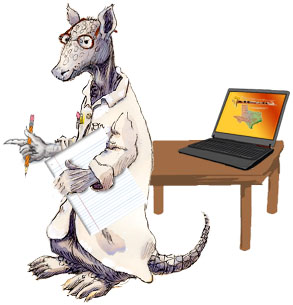Step 2: |
|
| Now... think about what you have learned from your research and explain it in your own words. |  |
| Begin by organizing your thoughts into an OUTLINE. | |
| Create a simple outline by following these steps. Remember that you can always add more sections, but this is the basic framework. | |
| Instructions | How to draw an outline |
| 1. Begin with an opening paragraph, or introduction. In your outline, label this with the Roman numeral one. In this section you will tell the reader what your paper will be about. | I. Opening Paragraph |
| 2. Decide on at least three of the most important things you want to discuss. In your outline, indent under the opening paragraph and label these: A, B, and C. | I. Opening Paragraph
B. Important thing 2 C. Important thing 3 |
| 3. For each of these important things, think of two or three things to say about them such as explanations, details, or specific examples. Indent again and label these: a, b, and c. Repeat this step for B and C. |
I. Opening Paragraph
C. Important thing 3 |
| 4. The end of your paper should be a closing paragraph. In your outline, label this as Roman numeral II. Here you will summarize what your paper was about and state your conclusions. |
I. Opening Paragraph
C. Important thing 3 II. Closing paragraph |
Tips: Sometimes, during your research, you will read a sentence or phrase that perfectly represents or explains your point, BUT YOU SHOULD NOT COPY SOMEONE ELSE'S WORK. That is called plagiarism, and it is cheating. |
You can include the information without stealing it in one of two ways: |
Way 1: Paraphrase with citation (reference)
|
Way 2: Quotation with citation (reference) If you really like the way another author expressed a thought or idea, use the original words but give credit to the author. Put quotation marks around the text and, within parentheses, provide a reference to where it came from. Include the name of the author and the date it was published, followed by the page number where you found the original text. For example, let's say you liked what anthropologist William Newcomb said at the end of his chapter about the Karankawa Indians in his book, The Indians of Texas. To make it clear you are going to use his words, refer to him specifically, then give his words, then give the citation to his book. Here's how that might look: As anthropologist William Newcomb said, "The Karankawas of the Texas Gulf Coast are gone, yet they will forever stir our imaginations. Perhaps this is because, unlike ourselves, they faced daily and directly the stark realities of remaining alive" (Newcomb 1961: 81). So that's it. You used another author's words and ideas and you've given credit with a reference. |
Way to go! Your almost finished! |
Texas Beyond History |
|
